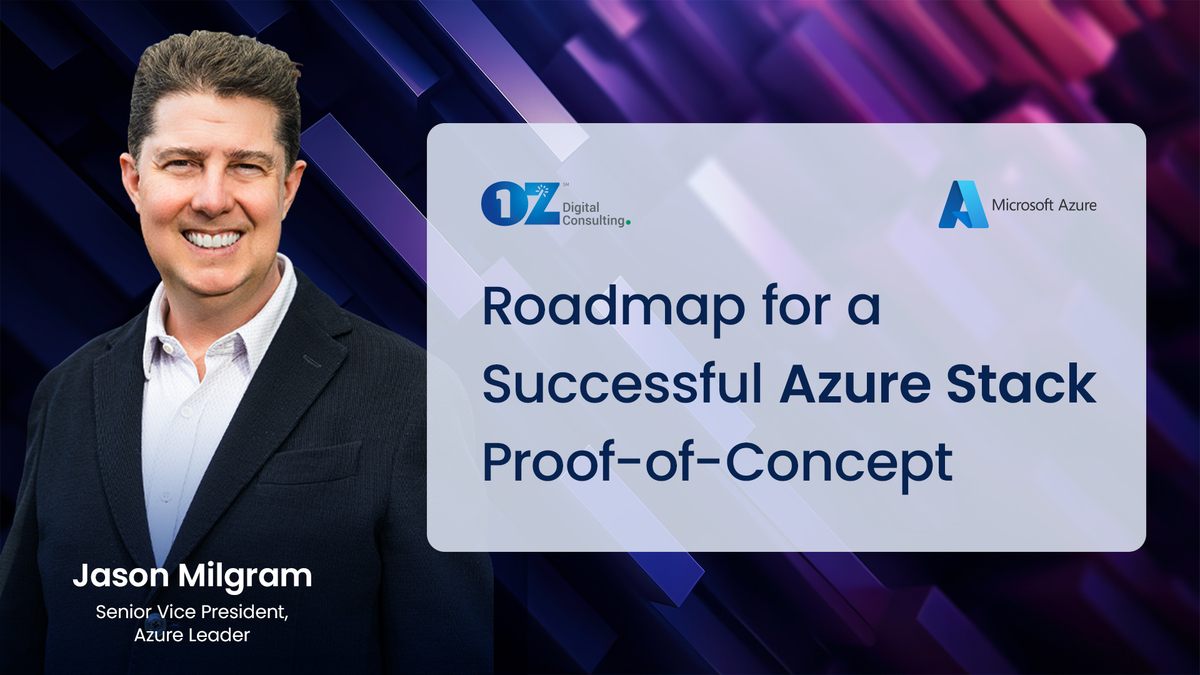By Jason Milgram, SVP Azure Leader
For business decision-makers, an Azure Stack proof-of-concept (POC) is an investment in certainty.
It provides a sandbox to validate the business impact of Azure Stack, test theories, and evaluate performance without the commitment of a full-scale deployment. Through POCs, decision-makers can see the potential of Azure Stack in action and assess how it aligns with their business objectives and technical prerequisites.
As such, a well-executed POC is not just a technical exercise; it is a strategic business initiative that can define a company’s trajectory of digital transformation journey.
Ready to learn how a POC can serve as a gateway to achieving operational excellence and a competitive edge?
Read on…
Roadmap for a Successful Azure Stack POC Engagement
Here are five essential checkpoints on your Azure Stack POC journey…
- Initial Assessment and Goal Setting. The first step in a POC is to conduct a thorough initial assessment. This means understanding the specific business objectives that Azure Stack can help achieve. It involves a deep dive into the current IT landscape and analyzing the technical requirements that align with the company’s broader business strategy. This stage is about setting clear, measurable goals and determining the scope of the POC to ensure that it is designed to effectively test hypotheses in a real-world scenario.
- Designing the POC. This is where strategic planning meets technical design. In this phase, decision-makers and IT teams collaborate to tailor the POC to address the business challenges identified in the assessment phase. The design must be robust enough to provide a meaningful test of Azure Stack’s capabilities and flexible enough to adapt to initial findings. This bespoke approach ensures that the POC will provide relevant insights and resolve any uncertainties with tangible evidence.
- Execution Phase. With a design in place, the execution phase involves setting up the Azure Stack environment and initiating the deployment. This phase is the heart of the POC, where teams can get hands-on experience with Azure Stack’s integration into their current systems. It is a time for IT staff to learn about the nuances of managing and operating Azure Stack and for decision-makers to start seeing the potential impacts of the technology on their operations.
- Evaluation and Analysis. Evaluation and analysis are critical to understanding the outcomes of the POC. Throughout the execution phase, monitoring tools and evaluation protocols collect data on Azure Stack’s performance and usage. This data serves as the backbone for assessing whether the POC meets the goals set out in the initial phase and provides insights into any areas needing refinement.
- Feedback and Iteration. A POC is not a one-and-done process; it is iterative. After the evaluation phase, feedback from all stakeholders is crucial. This feedback is used to iterate on the POC, adjust configurations, scale resources up or down, or re-evaluate user scenarios. This continuous loop of feedback and iteration helps fine-tune the system until the desired outcomes are achieved, ensuring that the final deployment of Azure Stack is optimized for the organization’s specific needs.
By following these structured steps, businesses can turn the POC into a powerful tool for decision-making and innovation.
Deliverables of a POC
Here is what stakeholders can expect to receive from a POC…
- Customized Use Cases. The heart of the POC’s value lies in its customized use cases. These demonstrate Azure Stack’s capabilities tailored to the business-specific needs identified in the assessment phase. They provide a concrete look at how Azure Stack can be applied in real-world scenarios the business faces daily. This deliverable gives life to theoretical benefits, highlighting practical applications and solutions that meet the organization’s unique challenges.
- Performance Benchmarks. Objective, data-driven performance benchmarks form the backbone of the POC’s evaluative process. These reports cover vital metrics such as speed, efficiency, and scalability. They provide a quantitative foundation for understanding how Azure Stack performs under various loads and how it can handle the organization’s demands. This information is vital for IT teams to ensure the system can sustain the business’s operational pace and growth trajectory.
- Security and Compliance Assessments. With ever-tightening data security and privacy regulations, the POC must deliver thorough security and compliance assessments. These evaluations analyze how well Azure Stack can protect sensitive data and adhere to industry-specific regulatory standards. The findings help reinforce the confidence of stakeholders in Azure Stack’s ability to mitigate risks and maintain compliance within the company’s regulatory framework.
- Cost-Benefit Analysis. A detailed cost-benefit analysis compares the investment in Azure Stack against the expected returns. This analysis looks at the financial implications of deploying Azure Stack and projects the return on investment (ROI) over time. It considers direct costs, like hardware and licensing fees, and indirect costs, such as increased productivity and operational efficiencies. The goal is to provide a clear financial picture to justify the investment.
The value of a proof-of-concept (PoC) cannot be overstated. It is a litmus test for Azure Stack’s practicality, efficiency, and impact within your unique business environment. The insights gained from this experiential journey provide a factual basis for decision-making and dispelling doubts with hard data and user experiences. The benchmarks set, the use cases validated, and the assessments conducted during the PoC phase offer a vivid picture of Azure Stack’s transformative potential.
The path forward is clear for those who have found success in their PoC. The evidence and understanding accrued argue powerfully for Azure Stack’s full-scale implementation. With the groundwork laid and a strategic deployment roadmap, businesses can transition smoothly from a testing phase to company-wide adoption.
Your Next Steps
The journey to integrating Azure Stack into your operations is a step into a realm of greater agility, innovation, and competitive advantage. It is an investment in the future of your business, promising to unlock new horizons and drive transformative business solutions.
As a certified Microsoft partner with more than a quarter century of experience, OZ is uniquely positioned to help you do just that.
Learn more here or reach out to schedule a consultation today.



